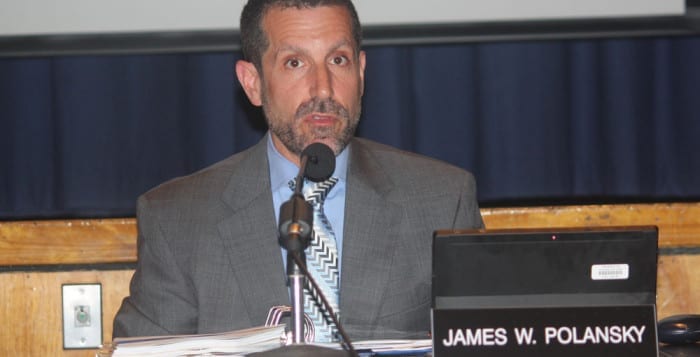With a possible deficit looming, the Smithtown Central School District board of education is moving closer to a decision on the fate of its eight elementary schools, following a public work session on Jan. 19 and a board meeting on Jan. 26.
Discussions between the school board and the community were getting emotional this week.
Superintendent James Grossane, with the help of Assistant Superintendent for Finance and Operations Andrew Tobin, backed up his five recommendations to the school board from a November 2015 housing report with statistics at the work session on Jan. 19.
“I can’t tell you that 2017-18 will be the deficit year, but it’s becoming more and more likely as we look out ahead that 2017-18, maybe 2018-19, if we don’t get those type of increases, we know our expenses are going to go up, we’re going to certainly be facing it at some point,” Tobin said during the work session.
At the work session the board, along with Grossane, discussed the findings of the housing report that made five recommendations, labeled Options 1 through 5, for money saving measures.
Of the five recommendations, all suggested closing at least one of the district’s eight elementary schools. Grossane’s report said that closing one elementary school would save the district $725,000 annually.
Four of the five options included closing Branch Brook Elementary, which caused an uprising among district parents and started a Save Branch Brook movement that included petitions, Facebook pages, presentations to the school board and matching blue T-shirts.
Meredith Lombardi, a resident in the district, made a heartfelt plea to the board on Tuesday night.
“I was in sixth grade and my school district was redistricted,” Lombardi said. “I was ripped from my school. I was told that I was going to be going to a new one.”
Lombardi expressed a fear of putting her three children through the same experience that she had.
“If you allow one of our schools to close, the children affected will never be the same,” Lombardi said.
Lombardi was one of eight “Save Branch Brook” parents who stepped up to the podium to address the board Tuesday night. Katie Healy was another.
“Branch Brook is our most efficient and cost effective school,” Healy said. “Branch Brook is not the school to close. It is the wrong place and the wrong time. Closing Branch Brook will not solve our district’s problems, it will just add more,” Healy said.
At the time that the recommendations were made, it was unclear what lead Grossane to suggest closing Branch Brook as a course of action. Parents from the Save Branch Brook contingent conducted their own housing-committee-style research and concluded that Branch Brook was the elementary school least deserving of closure based on building occupancy, square foot per student, students per usable classroom and utility cost.
They also offered their own recommendation, Option 6, which suggested that based on their findings Smithtown Elementary was the school that should be closed.
It is now clear what led Grossane to suggest Branch Brook for closure, records showed. The number of elementary school classrooms that feed students to the district’s two high schools must be close.
Currently, the eight elementary schools send 116 classrooms worth of students to Smithtown West when they reach ninth grade and 114 to Smithtown East, according to Grossane.
If Branch Brook were closed and district boundaries were not redrawn, 114 elementary classes would still be fed to East, while 96 would be sent to West.
This is a discrepancy that Grossane is comfortable with. Closing Smithtown Elementary, for example, which was put on the table by the community’s Option 6, would result in 114 elementary classrooms for East and 84 for West.
Grossane said that there would be no choice but to redistrict if that was the option that the board selected.
Additionally, the district needs to select a school for closure that does not leave their potential elementary school capacity vulnerable to growing enrollment. Grossane’s report said that even if the board chose Option 5, which would close Branch Brook and Dogwood Elementary schools, the district would be able to handle roughly 800 additional elementary students on top of the approximately 3,700 elementary school students enrolled for 2015-16 across the eight schools.
Closing one or two elementary schools would obviously increase average class size, though Grossane called instances where any classes would reach a district implemented maximum of 28 students “outliers.”
“Every school has a grade level that runs almost to maximum,” Grossane said at the work session. “If we close a building and we operate with seven, those outliers would smooth out. They’d shift. There would still be an outlier occasionally in every building. I’m not going to tell you there isn’t going to be a class in fifth grade that doesn’t have a 28 at some point within the next six years after we close a building, because there definitely will be. But it’s usually one grade per building. Most times, the class averages even out across the district.”
Members of the school board responded to Grossane’s findings as well as the overwhelming public comments from the previous meetings.
“I have been doing a lot of housing committee work over my time on the board,” Theresa Knox, a trustee on the board of education said on the 19th. “I’ve been through this within my own neighborhood, as many of you know. My children were not affected by the closing of Nesconset, but all of the children on the end of my little dead-end block were. And I have to look at them everyday. And they’re doing great.”
Knox responded to parents concerned about which elementary school their kids would be sent to if closures were carried out. “It had better be, that all of our elementary buildings are fine, educational, welcoming, nurturing, caring places.”
Discussions about the sale and/or repurposing of the district’s administration headquarters on New York Avenue in Smithtown are ongoing as well.
Public comments are not permitted during public work sessions. More debate and eventually a decision are inevitable in the coming weeks.
A date has not yet been selected for a vote on the matter.




















